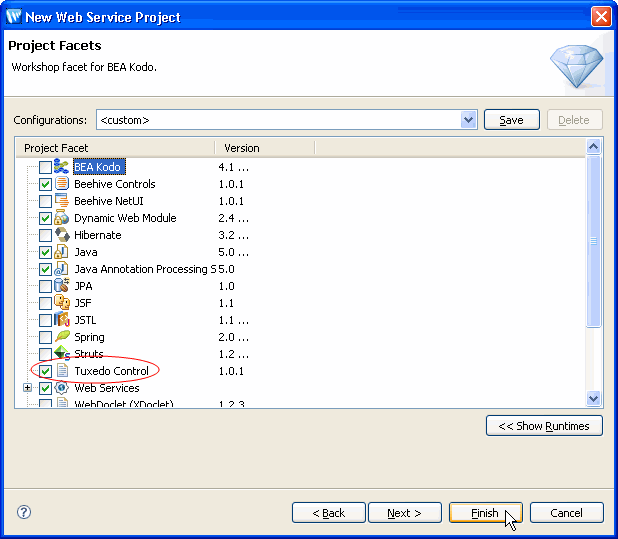How Do I: Use a Tuxedo Service in a Web Service
The Tuxedo control allows you to create a web service
or Workshop application that uses one or multiple Tuxedo services in its business
logic. The Tuxedo control is a generic interface. To use the control to communicate
with specific Tuxedo services, you must create a control. The control consists
of a Java interface and implementation file pair that tells the Tuxedo control
the names of the Tuxedo services you want to invoke, the type of interaction
the services require (service with reply, queued service, etc), and the Tuxedo
buffer types the services expect as input. Your application invokes the methods
defined by the control interface to invoke the Tuxedo services. After
you create a control for a specific set of Tuxedo services, you can
reuse the control in any application that needs to access those services.
Workshop does most of the work of creating a control for you.
In this section, the example shown represents creating
a web service.
To create a web service that uses a Tuxedo service:
Set Up Your Environments
- Start the Tuxedo server that advertises the Tuxedo service you want to use.
- Start Workshop.
- Start WebLogic Server. You can confirm
the status of WebLogic Server by checking the Server view.
Create a Web Service Project with the Tuxedo Control
Facet
Note: if you already have a web service project, you can
add the Tuxedo Control facet by right-clicking the project and select Properties
> Project Facets.
- Select File > New > Project.
- In the New Project dialog, select Web Services
> Web Service Project > Next.
- Enter a Project Name and click Next.
- In the Project Facets page, select Tuxedo Control and
click Next.

Create a Web Service
-
Create a new folder/package
in the src dir.
-
Right-click the new folder and select New
> WebLogic Web Service.
- Complete the wizard and click Ok.
Add a Tuxedo Control to Your Web Service
Controls act as interfaces between your web service
and other data sources. Therefore, you want to add a Tuxedo control to your
web service to provide your web service with access to Tuxedo services.
The tasks in this step are:
Use a Tuxedo Control
In this task you will use a Tuxedo Control file and then add a method to the control file.
- Open the web service in which you
want to use a Tuxedo service.
- Right-click in the web services Design view or Source
view and select Insert
> Control.
- From the Select Control menu, choose either an existing Tuxedo
control or choose New
System Control > Tuxedo Control and click Ok.
The New Control dialog displays.
- For a new control, follow the procedures described in How
Do I: Create a Tuxedo Control, to create a new Tuxedo control to
use in your application.
Create a WebLogic Tuxedo Connector (WTC) Service
WTC acts as a gateway between the Tuxedo environment and WebLogic environment; therefore, a WTC service definition must exist that maps to the Tuxedo service you want to use in your web service.
Import the Tuxedo service that you want to use in your web service. For information on how to import WTC services, see How Do I: Configure a WTC Service.
Use Public Methods from the Control
The Tuxedo control provides the following public methods
to use in your web service in addition to the methods defined by your control.
If you want to use these methods you must call them explicitly.
|
|
getConnection() |
Gets the WTC connection currently used by this control. This allows you to use more of the WTC APIs defined for a connection. getConnection() returns an instance of an ApplicationToMonitorInterface object that can be used to interact with Tuxedo through JATMI calls. Note: This method will not allow you to terminate the connection or use tpacall with asynchronous calls.
Using the getConnection() method assumes that the developer has a working knowledge of WTC calls. |
getMappingIssues() |
Returns an array of MappingIssues associated with the last request made. Mapping issues are generated by the control when there is a discrepancy between the Java data type and the Tuxedo buffer. |
gettpurcode() |
Returns the tpurcode associated with the last exception that occurred. |
gettperrno() |
Returns the tperrno associated with the last request made by the control. |
Use a Tuxedo Service from the Control
Next you must incorporate one or more methods from the
control just created in the previous step in your web service.
- Open the web service file in Design
view.
- Right-click the method on the Tuxedo
control and select Generate Delegate Method. This will
create a corresponding method in the web service.
For the web service to provide additional processing before or after the call to the Tuxedo service or if the web service needs a different signature, click the Source view tab and edit the Java code as needed.
- From the menu, select File > Save.
Test the Web Service Using Debugger
Next you will test your web service using debugger.
- Right-click the web service and select
Run As > Run on Server.
- The Workshop test client displays
with a place to enter the parameters for the web service method that
was previously added. Enter the appropriate parameters and click the
method name button.
- Verify the results that return at the bottom of the page when the test browser refreshed the window.
Related Topics

